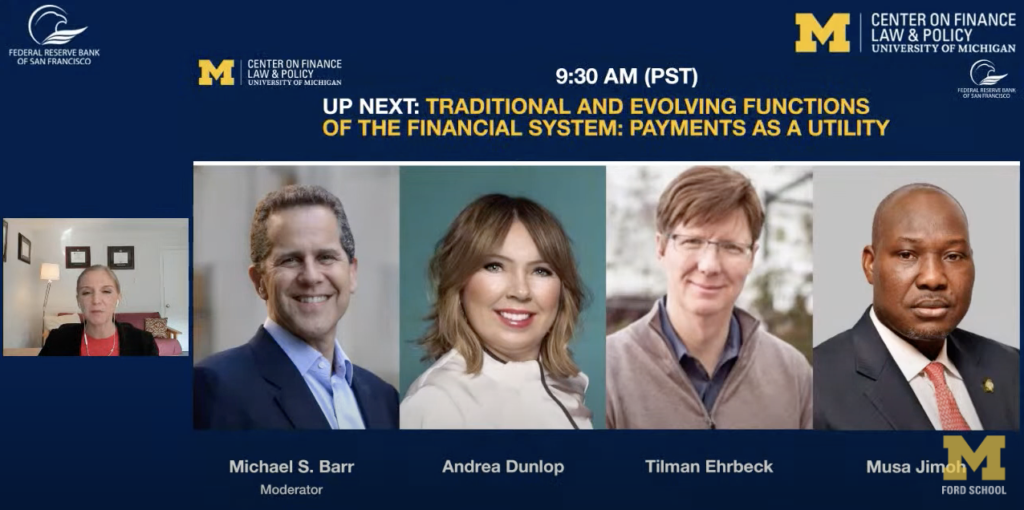[Event Recap] Are Payments a Platform, a Utility, or Both? Central Bank of the Future

More than any year in the past decade, 2020 put payment systems to the test as more than 200 national and regional governments globally authorized some form of COVID-19 relief, mostly in cash transfers to individuals.
“The countries with robust digital infrastructure did a better job,” said Flourish managing partner Tilman Ehrbeck on a November 17 panel on “Payments as a Utility” at Central Bank of the Future Conference. “India reached more than 100 million people with the click of a button. The U.S., for example, was not so lucky. Checks took up to three months to go out.”
Reflecting on the different experiences that these countries had, the panelists discussed what the ideal payments system of the future should look like and what is actually achievable. Joining Tilman in the discussion were:
- Michael Barr, Dean of the Ford School of Public Policy
- Andrea Dunlop, Managing Director, The Access Group
- Musa Jimoh, Director of Payments System Management, The Central Bank of Nigeria
The conference was co-hosted by the Federal Reserve Bank of San Francisco and the University of Michigan. The session was streamed live on YouTube, but you can read the highlights here.
The Ideal Payment System and the Reality
All panelists agreed that financial systems are at a crossroads between traditional roles and evolving functions. “This isn’t an easy step for central banks to take,” said Andrea. “How do they keep pace with technology, support their core infrastructure, and maintain a stable system?”
Andrea noted that the Bank of England has permitted a limited number of fintechs to connect to its settlement systems. Opening up helps future proof the financial system, but she believes it could raise additional risks that we hadn’t considered in the past.
Many countries open up gradually, through regulatory sandboxes. Of course, every country’s payments system takes a different shape based on variables including a dense ecosystem of private-sector technologies, banking networks, government regulations, public rails, identity regimes, telecoms and merchants.
In Nigeria, Musa shared, the central bank runs the real-time bank-to-bank settlement network, and performs the usual supervisory role. However, the rest of the payments infrastructure is run by the private sector. “I think the central bank should provide the guidelines, as a regulator,” he said, “letting banks and fintechs perform all other functions.”
Whether run by the private sector and regulated, run by a public entity like the central bank, or run by a nonprofit consortium, all panelists agreed that a payments system should be inclusive and protect consumers.
“I take two lenses,” Tilman said. “One is first principles, thinking through what in a financial system is a public good. Where are there network externalities and natural monopolies? Retail payments, I would argue, have characteristics of a public utility and should be regulated as such. In an ideal system, the private sector competes at the application layer. The second lens is pragmatic. What infrastructure already exists in the country? What can we build on? Nobody starts from scratch.”
Key Layers in the Payments Stack
An inclusive, consumer-centric payment system should be real-time and fully interoperable, enabling any-to-any push and pull transactions. Governments should prioritize for a more inclusive payments system with a digital identity. It was this layer that made the India Stack so successful.
A country’s telecom infrastructure and the last mile, or cash-in and cash-out access points are an important part of the bigger picture. “To bring more Nigerians into the banking sector, we had to make bank accounts more appealing, so having a vast network of agent outlets was important,” said Musa. Expanding that network into the hinterlands requires electricity and telecom hookups.
These brick-and-mortar barriers are not limited to developing markets. In the UK, “we still have 23% of people who struggle to access broadband,” Andrea said. “And we realized after COVID hit, how many people draw cash regularly, especially elderly people.”
The final point of discussion was the data layer that enables further financial services on top of payments, such as alternative credit and insurance. In 2018, the UK’s Open Banking nonprofit coordinator launched a payments initiation API for fintechs to push payments to merchants, straight from consumers’ bank accounts. “It’s a very simple process without all the layers in between. It removes a lot of friction,” said Andrea. “I think we’ll see a lot of disintermediation coming in the future, around these rails.”
Disintermediation could benefit consumers historically excluded from or penalized by the payments system.
It might even upend the longstanding reverse Robin Hood subsidy in America’s fee structure. In the U.S., where the credit card interchange is relatively high, a share is returned to credit card users in points or cash back. However, lower-income consumers tend to use debit card or cash, transferring according to a Boston Federal Reserve study an average $1,000 a year from America’s poor to rich households.